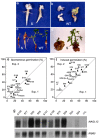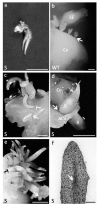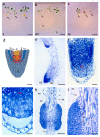Overexpression of MADS-box Gene AGAMOUS-LIKE 12 Activates Root Development in Juglans sp. and Arabidopsis thaliana
- PMID: 32252382
- PMCID: PMC7238194
- DOI: 10.3390/plants9040444
Overexpression of MADS-box Gene AGAMOUS-LIKE 12 Activates Root Development in Juglans sp. and Arabidopsis thaliana
Abstract
Until recently, the roles of plant MADS-box genes have mainly been characterized during inflorescence and flower differentiation. In order to precise the roles of AGAMOUS-LIKE 12, one of the few MADS-box genes preferentially expressed in roots, we placed its cDNA under the control of the double 35S CaMV promoter to produce transgenic walnut tree and Arabidopsis plants. In Juglans sp., transgenic somatic embryos showed significantly higher germination rates but abnormal development of their shoot apex prevented their conversion into plants. In addition, a wide range of developmental abnormalities corresponding to ectopic root-like structures affected the transgenic lines suggesting partial reorientations of the embryonic program toward root differentiation. In Arabidopsis, AtAGL12 overexpression lead to the production of faster growing plants presenting dramatically wider and shorter root phenotypes linked to increased meristematic cell numbers within the root apex. In the upper part of the roots, abnormal cell divisions patterns within the pericycle layer generated large ectopic cell masses that did not prevent plants to grow. Taken together, our results confirm in both species that AGL12 positively regulates root meristem cell division and promotes overall root vascular tissue formation. Genetic engineering of AGL12 expression levels could be useful to modulate root architecture and development.
Keywords: cell differentiation; cell division; root meristem; transcription factor; transgenic plant.
Conflict of interest statement
The authors declare no conflict of interest.
Figures




Similar articles
-
MADS-box gene expression in lateral primordia, meristems and differentiated tissues of Arabidopsis thaliana roots.Planta. 2002 Jan;214(3):365-72. doi: 10.1007/s004250100637. Planta. 2002. PMID: 11855641
-
Expression of MADS-box genes during the embryonic phase in Arabidopsis.Plant Mol Biol. 2005 May;58(1):89-107. doi: 10.1007/s11103-005-4546-3. Plant Mol Biol. 2005. PMID: 16028119
-
The MADS-box gene DEFH28 from Antirrhinum is involved in the regulation of floral meristem identity and fruit development.Plant J. 2001 Oct;28(2):169-79. doi: 10.1046/j.1365-313x.2001.01139.x. Plant J. 2001. PMID: 11722760
-
Diverse roles for MADS box genes in Arabidopsis development.Plant Cell. 1995 Aug;7(8):1259-69. doi: 10.1105/tpc.7.8.1259. Plant Cell. 1995. PMID: 7549482 Free PMC article.
-
The major clades of MADS-box genes and their role in the development and evolution of flowering plants.Mol Phylogenet Evol. 2003 Dec;29(3):464-89. doi: 10.1016/s1055-7903(03)00207-0. Mol Phylogenet Evol. 2003. PMID: 14615187 Review.
Cited by
-
BnAP2-12 overexpression delays ramie flowering: evidence from AP2/ERF gene expression.Front Plant Sci. 2024 Mar 25;15:1367837. doi: 10.3389/fpls.2024.1367837. eCollection 2024. Front Plant Sci. 2024. PMID: 38590749 Free PMC article.
-
Genomic and Transcriptomic Insights into the Evolution and Divergence of MIKC-Type MADS-Box Genes in Carica papaya.Int J Mol Sci. 2023 Sep 13;24(18):14039. doi: 10.3390/ijms241814039. Int J Mol Sci. 2023. PMID: 37762345 Free PMC article.
-
Genome-wide identification and expression pattern analysis of MIKC-Type MADS-box genes in Chionanthus retusus, an androdioecy plant.BMC Genomics. 2024 Jul 2;25(1):662. doi: 10.1186/s12864-024-10569-8. BMC Genomics. 2024. PMID: 38956488 Free PMC article.
-
Genome-Wide Analysis of the Mads-Box Transcription Factor Family in Solanum melongena.Int J Mol Sci. 2023 Jan 3;24(1):826. doi: 10.3390/ijms24010826. Int J Mol Sci. 2023. PMID: 36614267 Free PMC article.
-
Genome-Wide Analysis and the Expression Pattern of the MADS-Box Gene Family in Bletilla striata.Plants (Basel). 2021 Oct 14;10(10):2184. doi: 10.3390/plants10102184. Plants (Basel). 2021. PMID: 34685993 Free PMC article.
References
-
- Alvarez-Buylla E.R., Liljegren S.J., Pelaz S., Gold S.E., Burgeff C., Ditta G.S., Vergara-Silva F., Yanofsky M.F. MADS-box gene evolution beyond flowers: Expression in pollen, endosperm, guard cells, roots and trichomes. Plant J. 2000;24:457–466. doi: 10.1046/j.1365-313x.2000.00891.x. - DOI - PubMed
LinkOut - more resources
Full Text Sources
Miscellaneous

